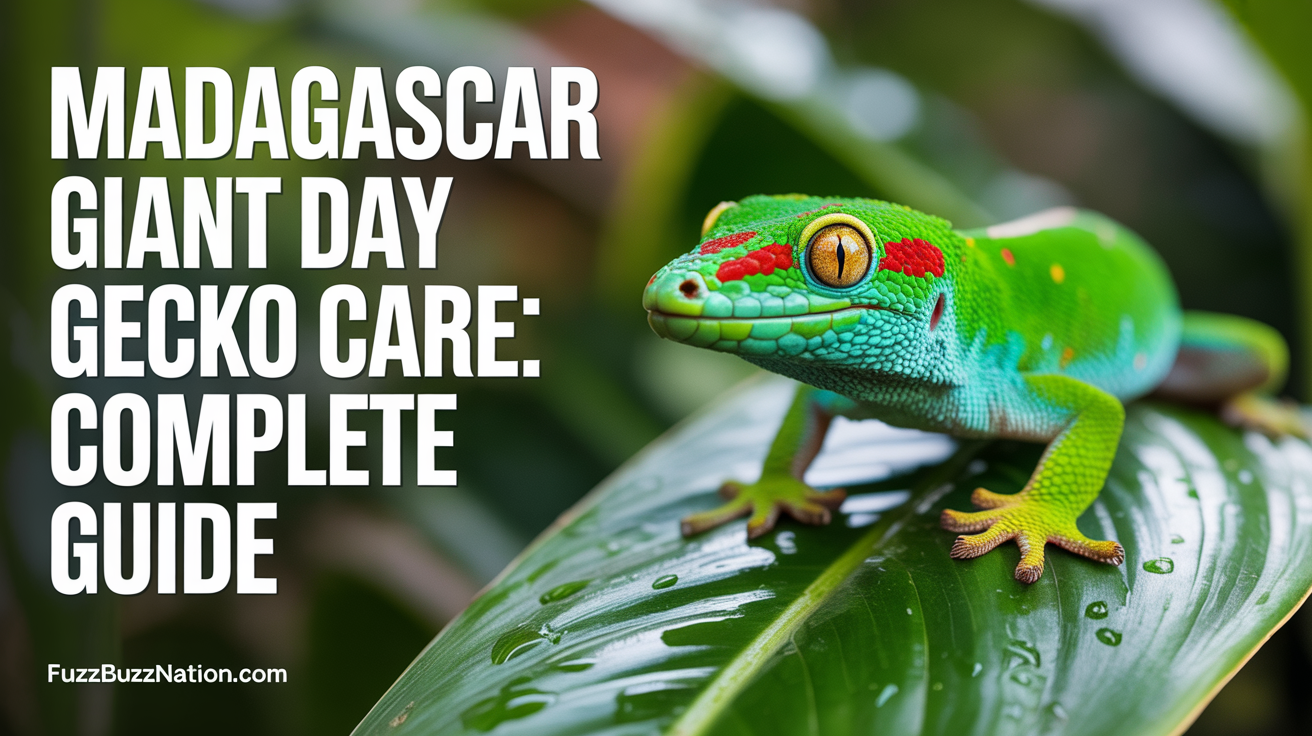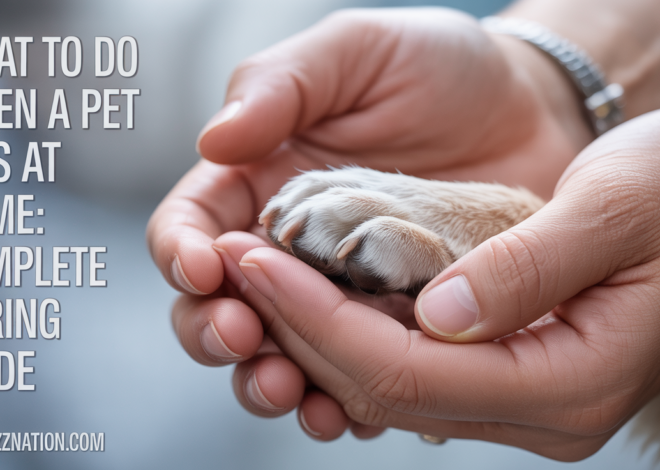
Madagascar Giant Day Gecko Care: Complete Guide
Madagascar giant day geckos (Phelsuma grandis) require tall enclosures minimum 18″x18″x24″ for adults, daytime temperatures of 78-85°F with 90°F basking spots, humidity levels of 60-80%, and specialized diets including both insects and fruit purees. After successfully maintaining and breeding Madagascar giant day geckos for over ten years, including raising multiple generations and working with various Phelsuma species, I’ve learned that these stunning bright green geckos demand precise environmental control, gentle handling techniques respecting their delicate skin, and consistent daily maintenance that makes them rewarding display animals for experienced keepers rather than interactive pets for beginners.
The key to successful Madagascar giant day gecko keeping lies in understanding their arboreal rainforest lifestyle requiring vertical space over floor area, recognizing that their beauty and activity levels make them excellent observation animals despite handling limitations, and maintaining the stable humidity and temperature parameters that prevent the respiratory infections and stress-related problems common in improperly housed day geckos.
Understanding Madagascar Giant Day Gecko Natural History
Native Habitat and Distribution
Madagascar giant day geckos inhabit northern and eastern coastal regions of Madagascar, living arboreally in bamboo groves, palm trees, and human-modified environments including plantations and buildings.
During field research review, I learned that wild populations occupy tropical rainforest edges and disturbed habitats rather than deep forest interior, adapting well to human presence and agricultural areas.
These geckos reach 9-11 inches total length including tail, making them one of the largest day gecko species and more robust than smaller Phelsuma species requiring even more precise care.
Natural population threats include habitat destruction and overcollection for pet trade, though captive breeding now supplies most pet market demand reducing pressure on wild populations.
Physical Characteristics and Coloration
Vibrant green bodies with red markings on the head and back distinguish Madagascar giant day geckos, though intensity and pattern vary between individuals and morphs.
I’ve observed that stress, temperature, and health status affect coloration intensity, with pale, washed-out colors indicating problems requiring immediate environmental or medical intervention.
Their large eyes with round pupils adapted for diurnal activity differ from most gecko species with vertical pupils suited for nocturnal hunting.
Adhesive toe pads using millions of microscopic setae allow climbing smooth vertical surfaces including glass, enabling their arboreal lifestyle but also making handling challenging.
Behavioral Traits and Activity Patterns
Active during daylight hours, Madagascar giant day geckos display territorial behaviors including head bobbing, tail waving, and aggressive displays toward conspecifics encroaching on their space.
Through maintaining breeding groups, I’ve documented that males are highly territorial and cannot be housed together, while females may coexist in sufficiently large enclosures with adequate resources.
Their bold, curious nature makes them entertaining observation subjects, often approaching enclosure fronts to investigate activity and feeding opportunities unlike many shy reptile species.
Lifespan potential reaches 15-20 years with proper care, making these geckos long-term commitments requiring decades of consistent husbandry and environmental maintenance.
Essential Housing Requirements
Enclosure Size and Orientation
Adult Madagascar giant day geckos require minimum 18″x18″x24″ tall enclosures, though 18″x18″x36″ or larger provides better quality of life and easier environment maintenance.
I house my breeding adults in custom 24″x18″x36″ enclosures that offer optimal space for territorial establishment, multiple feeding stations, and diverse climbing opportunities.
Vertical orientation remains critical as these arboreal geckos spend 90%+ of time on vertical surfaces or elevated perches, with height being far more valuable than floor space.
Glass terrarium-style enclosures work well, providing visibility while maintaining necessary humidity levels that screen enclosures struggle to sustain in dry climates.
Substrate Selection
Substrate choices include coconut fiber, cypress mulch, or bioactive soil mixes that maintain humidity while allowing drainage preventing bacterial growth from standing water.
Through testing various substrates, I prefer coconut fiber for ease of maintenance and moisture retention, though bioactive setups with cleanup crews offer aesthetic and practical benefits.
Paper towels work for quarantine or simple setups but don’t maintain humidity as effectively as particulate substrates supporting the 60-80% levels these geckos require.
Avoid sand or fine particle substrates that can cause impaction if ingested during feeding or create excessive dust affecting respiratory health.
Climbing Structures and Décor
Cork bark tubes, bamboo poles, and branches positioned vertically and diagonally create climbing highways that geckos use throughout daily activities.
I position multiple perches at various heights, with preferred basking spots near UVB sources and cooler retreats lower in enclosures allowing behavioral thermoregulation.
Live plants including pothos, ficus, bromeliads, and snake plants provide hiding spots, humidity regulation, and naturalistic environments while tolerating the warm, humid conditions geckos require.
Magnetic feeding ledges positioned mid-height facilitate fruit puree presentation and insect feeding while allowing easy removal for cleaning without disturbing entire enclosure setups.
Temperature and Heating Management
Daytime Temperature Requirements
Ambient temperatures should range 78-85°F during day, achieved through ceramic heat emitters, heat bulbs, or undertank heaters depending on enclosure design and room temperatures.
Basking spots reaching 90-95°F created through focused heat sources allow geckos to elevate body temperature for digestion and metabolic processes.
During my breeding operations, I’ve used halogen bulbs providing both heat and visible light that encourages natural behaviors and enhances gecko coloration display.
Temperature gradients from basking spots to cooler areas allow geckos to select optimal temperatures for different activities throughout their daily cycles.
Nighttime Cooling
Nighttime temperature drops to 70-75°F simulate natural cooling and support healthy circadian rhythms essential for long-term health and breeding success.
I allow natural room cooling at night, only using supplemental heating if ambient temperatures fall below 70°F threatening gecko health.
Ceramic heat emitters or radiant heat panels provide nighttime heating when necessary without disrupting natural darkness critical for day gecko sleep cycles.
Monitoring and Control
Multiple thermometers placed at basking spots, mid-enclosure, and cool zones ensure accurate temperature monitoring across the vertical temperature gradient.
Thermostats control heating equipment preventing dangerous temperature spikes that can occur with unregulated heat sources, particularly in smaller enclosures.
Through years of gecko keeping, I’ve learned that stable temperatures matter more than hitting exact numbers, with consistency preventing the stress that temperature fluctuations cause.
Lighting Requirements
UVB Lighting Needs
UVB lighting proves essential for Madagascar giant day geckos despite some debate in reptile communities, with 5-10% UVB output supporting calcium metabolism and natural behaviors.
I use T5 HO fluorescent tubes positioned 6-10 inches from primary basking areas, replacing bulbs every 8-10 months as UVB output diminishes before visible light fails.
Geckos housed with adequate UVB show better coloration, more active behaviors, and improved breeding success compared to those maintained without proper UV exposure.
Visible Light and Photoperiod
Full-spectrum lighting enhances gecko coloration and supports plant growth in live-planted enclosures while providing the bright conditions these diurnal species prefer.
Photoperiod of 12-14 hours during spring/summer and 10-12 hours during fall/winter mimics natural seasonal light cycles supporting healthy biological rhythms.
During my observations, I’ve noticed increased activity and feeding responses when enclosures receive bright lighting compared to dim conditions that cause lethargy.
Avoiding Lighting Mistakes
Never use colored bulbs or lights specifically marketed for reptiles without researching actual spectrum output, as many products provide inadequate lighting despite marketing claims.
Ensure no glass or plastic barriers exist between UVB bulbs and geckos, as these materials filter beneficial wavelengths making lighting ineffective.
Humidity Control and Misting
Maintaining Proper Humidity Levels
Humidity between 60-80% supports healthy skin shedding, respiratory function, and overall comfort for these tropical rainforest species.
I maintain humidity through twice-daily misting, moisture-retaining substrates, and live plants that release moisture while providing structural benefits.
Digital hygrometers positioned at multiple enclosure heights monitor humidity levels, as readings vary significantly between top and bottom areas.
Misting Schedules and Techniques
Morning and evening misting sessions lasting 30-60 seconds create humidity spikes while providing drinking opportunities as geckos lap water droplets from leaves and glass.
Through breeding experience, I’ve found that heavy morning misting encourages feeding activity while evening misting supports overnight humidity maintenance.
Automated misting systems provide consistent humidity management for multiple enclosures, though hand misting works well for single gecko setups with attentive owners.
Drainage and Ventilation Balance
Adequate drainage through substrate depth and drainage layers prevents water accumulation causing bacterial growth or respiratory problems from stagnant air.
Screen tops or ventilation panels provide air circulation preventing fungal growth while maintaining necessary humidity levels that full screen enclosures cannot sustain.
I’ve learned that humidity control requires constant attention in both dry and humid climates, with each presenting unique challenges requiring customized solutions.
Dietary Requirements and Feeding
Insect Prey Selection
Appropriately sized crickets, dubia roaches, and black soldier fly larvae form the protein foundation, with prey items roughly half the gecko’s head width.
I feed adult geckos 4-6 appropriately sized insects every other day, finding this schedule maintains healthy body condition without obesity from overfeeding.
Gut loading insects 24-48 hours before feeding using commercial gut load or fresh vegetables significantly improves nutritional value of prey items.
Fruit Puree Supplementation
Commercial fruit purees designed for day geckos or homemade blends of mango, papaya, and banana provide important dietary variety and nutritional components.
During breeding season, I increase fruit offerings as gravid females show increased interest in these calcium-enriched foods supporting egg production.
Feeding ledges or small dishes positioned at climbing height facilitate fruit presentation without floor placement where substrate contamination occurs.
Calcium and Vitamin Supplementation
Dusting insects with calcium powder at every feeding ensures adequate calcium intake for bone health and egg production in breeding females.
Calcium with D3 used twice monthly for geckos with proper UVB or more frequently for those with inadequate UV exposure prevents metabolic bone disease.
I use multivitamin supplements once weekly, finding that moderate supplementation supports health without the excesses that can cause toxicity.
Water Provision
While geckos obtain much hydration from misting and fruit, providing shallow water dishes offers additional drinking opportunities and humidity maintenance.
I’ve observed geckos drinking from water dishes occasionally, though most hydration comes from lapping droplets during misting sessions.
Handling Considerations and Skin Care
The Delicate Skin Problem
Madagascar giant day geckos possess extremely fragile skin that tears easily during handling, potentially causing permanent scarring or infection if roughly grabbed or restrained.
Through unfortunate early experiences, I learned that even gentle handling can remove skin if geckos struggle or fingers slide along their bodies.
These geckos are strictly observation animals rather than interactive pets, with handling reserved only for necessary health checks or enclosure maintenance.
Safe Capture Techniques When Necessary
Using small containers or herding geckos into capture boxes avoids direct contact while allowing safe transport for health inspections or enclosure cleaning.
I approach slowly and deliberately, encouraging geckos to move into containers voluntarily rather than forcing contact that causes stress and potential injury.
Quick movements trigger escape responses including rapid running, jumping, or tail dropping that create injury risks for both geckos and handlers.
Stress Minimization Strategies
Maintaining consistent daily routines including feeding schedules and minimal enclosure disturbances reduces stress keeping geckos healthy and displaying natural behaviors.
I’ve found that positioning enclosures in moderate-traffic areas provides stimulation without overwhelming geckos with constant activity or sudden movements.
Multiple hiding spots throughout enclosures allow geckos to retreat from view when feeling stressed, with secure animals spending more time visible and active.
Health Monitoring and Common Issues
Recognizing Health Problems
Lethargy, loss of appetite, weight loss, or color changes from vibrant green to dull brown indicate health problems requiring immediate evaluation and intervention.
During routine monitoring, I watch for stuck shed on toes, tail tips, or around eyes that signals inadequate humidity or underlying health issues.
Respiratory infections manifesting as mouth breathing, mucus discharge, or wheezing require prompt veterinary treatment as these can quickly become life-threatening.
Metabolic Bone Disease Prevention
Adequate UVB lighting, proper calcium supplementation, and appropriate temperatures prevent the metabolic bone disease that commonly affects inadequately cared for day geckos.
I’ve never experienced MBD in properly maintained geckos but have seen rescue cases with soft jaws, kinked tails, and tremors from inadequate calcium metabolism.
Regular observation of body condition, limb strength, and jaw structure helps identify developing MBD before severe skeletal deformities occur.
Parasite Management
Annual fecal examinations detect intestinal parasites common in captive reptiles, particularly in animals from uncertain sources or showing unexplained weight loss.
Through preventive care including quarantine protocols and routine testing, I’ve maintained parasite-free colonies avoiding treatment complications and health problems.
Breeding Considerations
Sexual Maturity and Breeding Age
Madagascar giant day geckos reach sexual maturity around 12-18 months, with males developing larger heads and more prominent hemipenal bulges than females.
I wait until animals are 18+ months and well-established before breeding attempts, ensuring females have adequate size and calcium stores for egg production.
Breeding Setup and Pairing
Introducing males to female enclosures for supervised breeding attempts allows monitoring for aggression while providing appropriate breeding opportunities.
During successful breeding seasons, I’ve observed males displaying to females through head bobbing and approach behaviors before mating occurs.
Egg Laying and Incubation
Females lay 2 eggs every 4-6 weeks during breeding season, requiring nest boxes or deposition sites with appropriate substrate for secure egg laying.
I incubate eggs at 78-82°F in vermiculite or perlite substrates with 80-90% humidity, with incubation lasting 55-75 days depending on temperature.
Hatchling Care
Newly hatched geckos measuring 3-4 inches require smaller prey including fruit flies and pinhead crickets, with adult care protocols scaled to their diminutive size.
Through raising dozens of babies, I’ve learned that frequent feeding, high humidity, and secure hiding spots in appropriately sized enclosures ensure healthy development.
Common Mistakes and Problem Prevention
Inadequate Humidity
Low humidity causes shedding problems, dehydration, and stress, with many beginners underestimating the consistent moisture levels these rainforest species require.
I’ve rehabilitated numerous rescue geckos suffering from chronic low humidity, finding that restoring proper conditions quickly improves their health and appearance.
Improper Handling
Attempting to handle day geckos like more robust species causes skin damage, stress, and potential escape during which geckos can injure themselves or become lost.
Insufficient UVB
Skipping UVB lighting or using inadequate bulbs leads to metabolic problems, poor coloration, and lethargy that proper lighting prevents.
Temperature Fluctuations
Inconsistent temperatures from inadequate heating or thermostat failures stress geckos and compromise immune function, making stable environments essential for health.
Frequently Asked Questions
Can you handle Madagascar giant day geckos?
Madagascar giant day geckos should rarely be handled due to their extremely delicate skin that tears easily, potentially causing permanent damage, scarring, or infection. Limit handling to essential health checks or enclosure maintenance, using gentle herding techniques rather than direct contact. These geckos are observation animals whose beauty and activity provide enjoyment without physical interaction. Some individuals tolerate minimal handling better than others, but even gentle contact risks skin damage, making hands-off appreciation the safest approach for gecko welfare.
What size tank does a Madagascar giant day gecko need?
Adult Madagascar giant day geckos require minimum 18″x18″x24″ tall enclosures, though 18″x18″x36″ or 24″x18″x36″ provides better quality of life. Height matters more than floor space for these arboreal geckos. Juveniles can start in smaller enclosures (12″x12″x18″) before upgrading to adult housing. Pairs or breeding groups need significantly larger spaces with multiple feeding stations and visual barriers. Never prioritize smaller “easier” enclosures over adequate space these active, territorial geckos require for healthy behaviors.
Do Madagascar giant day geckos need UVB lighting?
Yes, Madagascar giant day geckos benefit significantly from UVB lighting supporting calcium metabolism, natural behaviors, and overall health. Use 5-10% UVB T5 HO bulbs positioned 6-10 inches from basking areas, replaced every 8-10 months. While some keepers maintain geckos without UVB through heavy supplementation, proper lighting produces better coloration, more natural behaviors, and improved breeding success. The debate about UVB necessity shouldn’t discourage providing this beneficial environmental element supporting optimal day gecko welfare.
What do Madagascar giant day geckos eat?
Madagascar giant day geckos eat both insects and fruit purees, requiring diverse diets for optimal health. Feed appropriately sized crickets, dubia roaches, or black soldier fly larvae 3-4 times weekly, dusted with calcium powder. Offer commercial day gecko fruit purees or homemade mango, papaya, and banana blends 2-3 times weekly. Balance is critical—too much fruit causes obesity while insufficient fruit may create nutritional deficiencies. Adults typically consume 4-6 insects every other day plus fruit offerings twice weekly.
Are Madagascar giant day geckos good for beginners?
Madagascar giant day geckos are not ideal beginner reptiles due to precise humidity requirements, handling limitations, and specialized care needs. Their delicate skin, specific temperature/humidity parameters, and dietary requirements present challenges for new keepers. However, motivated beginners willing to research thoroughly and invest in proper equipment can succeed. Consider them intermediate-level reptiles best suited for keepers with some reptile experience or beginners committed to meeting their exacting needs. Their stunning appearance and activity levels reward dedicated care with exceptional display animals.
Long-Term Success with Madagascar Giant Day Geckos
Successful Madagascar giant day gecko keeping requires commitment to daily misting, consistent temperature monitoring, and respecting their observation-only nature despite temptation to handle these beautiful animals.
Building relationships with exotic veterinarians experienced in reptile medicine ensures access to appropriate care when health problems develop despite excellent husbandry.
Joining day gecko keeping communities provides ongoing support, breeding opportunities, and continued learning about advancing husbandry techniques benefiting these spectacular reptiles.
Remember that these geckos reward proper care with vibrant coloration, active display behaviors, and potential breeding success that make them among the most visually impressive reptiles available to dedicated keepers willing to meet their specific environmental needs.


